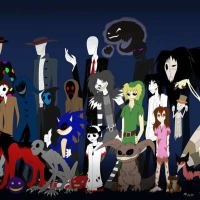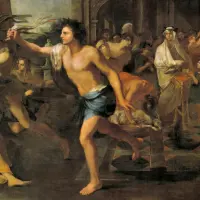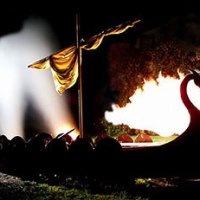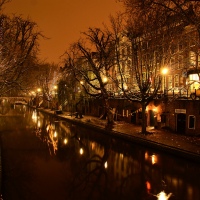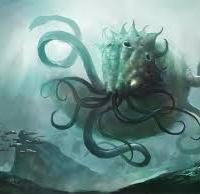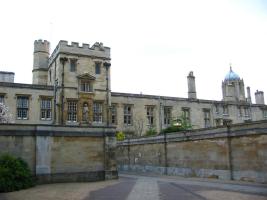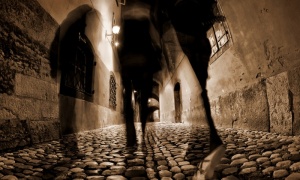With Christmas fast approaching and the ghost story season with it, this is perhaps a useful time to ask where the phenomenon of the Haunted House story first came from. For some, what effectively launched the genre of Haunted House stories was The Haunted and the Haunters, described by H P Lovecraft himself as “one of the best short haunted house tales ever written.” It is based on reports the writer, Edward Bulwer-Lytton, had heard about a building in the heart of London’s Mayfair, but it is also perhaps based on his own real life experiences. Lytton was born in London in 1803 and, despite his noble birth, was forced to earn his living as a writer, until he inherited the title of Lord Lytton in 1866. In the interim, he had become popular with readers for his historical novels – notably The Last Days of Pompeii (1834) – and a number of stories of the occult and supernatural. Highly regarded among these are his novel A Strange Story (1861) and short story Glenallan. The family seat of Lord Lytton was Knebworth House, a notable Tudor mansion, with a beautiful Jacobean banqueting hall, overlain with a 19th century Victorian Gothic exterior. Knebworth House has been the home of the Lytton family since 1490 and boasts some hauntings of a deeply personal nature. For example, the family is warned of an impending death by the sound and occasional sighting of a girl named Jenny, spinning. Other phenomena include a presence in the rooms once frequented by Edward Bulwer-Lytton himself, who died in 1873, and some believe he may have decided to remain there. “The pen is mightier than the sword” – an iconic proverb coined by Lytton in 1839 – is a phrase which makes regular appearances to this very day; just like its creator, the ghost of whom is said to haunt the gothic stately home where he once lived.
The Most Haunted Places in Dorset
19 Sep
The distant past is perhaps more tangible in Dorset than in any other part of England. Predominantly rural, this county overlaps substantially with the ancient kingdom of Wessex, whose most famous ruler, Alfred the Great, repulsed the Danes in the ninth century and came close to establishing the first unified state in England. Before Wessex came into being, however, many earlier civilizations had left their stamp on the region. The chalky uplands of nearby Wiltshire boast several of Europe’s greatest Neolithic sites, including Stonehenge and Avebury, while in Dorset you’ll find Maiden Castle, the most striking Iron Age hill fort in the country, and the Cerne Abbas Giant, source of many a legend. The Romans tramped all over this southern county, leaving the most conspicuous signs of their occupation at the amphitheatre of Dorchester – though that town is more closely associated with the novels of Thomas Hardy and his distinctively gloomy vision of Wessex. None of the landscapes of this region could be described as grand or wild, but the countryside is consistently seductive, its appeal exemplified by the crumbling fossil-bearing cliffs around Lyme Regis, the managed woodlands of the New Forest, or the gentle, open curves of Salisbury Plain. With this weight of history it is hardly surprising to hear that Dorset has often been called one of the most haunted parts of the British Isles. You can feel your skin crawl as you stand amidst the ghostly occupants of Dorset’s spooky pubs, stately homes and historic buildings, where paranormal activity haunts the grounds and current residents. From whispering voices and swirling white mists to eerie spirits and ghastly ghouls, Dorset is full of haunted locations and ghost stories, guaranteed to leave you with a chill.
The doppelgänger effect
15 Aug
A doppelgänger is a mysterious, exact double of a living person. It’s a German word that literally translates to “double walker” or “double goer”. A doppelganger isn’t someone who just resembles you, but is an exact double, right down to the way you walk, act, talk, and dress. A friend or even a close relative who encounters your doppelganger will swear it was you, even though you can prove you were not in the location the double was sighted. Although the word doppelgänger is often used in a more general and neutral sense, and in slang, to describe any person who physically resembles another person, in German folklore it is used to described a wraith or apparition of a living person, as distinguished from a ghost. The concept of the existence of a spirit double, an exact but usually invisible replica of every man, bird, or beast, is an ancient and widespread belief. To meet one’s double is a sign that one’s death is imminent. The doppelgänger became a popular symbol of horror literature, and the theme took on considerable complexity. In The Double (1846), by Fyodor Dostoyevsky, for example, a poor clerk, Golyadkin, driven to madness by poverty and unrequited love, beholds his own wraith, who succeeds in everything at which Golyadkin has failed. Finally the wraith succeeds in disposing of his original. An earlier, well-known story of a doppelgänger appears in the 1815 novel The Devil’s Elixir, by the German writer of fantastic tales E.T.A. Hoffmann. In fiction and mythology, a doppelgänger is often portrayed as a ghostly or paranormal phenomenon and usually seen as a harbinger of bad luck. Other traditions and stories equate a doppelgänger with an evil twin. In modern times, the term twin stranger is occasionally used.
Mystery of the Mothman
20 Jun
Perhaps the most widely known and talked about modern American myth is that of the Mothman, a creature first documented in the late 1960s. Since then, the Mothman has been spotted countless times in the United States. Some say it’s a harbinger of cataclysmic events. Others say it’s an alien life form with connections to UFOs and Men in Black. Many thing it has a more practical explanation, is a hoax, or is the product of mass hysteria. Whatever the case, the Mothman continues to pop up in real life and pop culture and is one of the more intriguing examples of modern American folklore – something where a quick Google search can’t dissuage its origins; something that permeates the minds of the people inflicted and the communities that branch off of them; a thing that lingers and re-manifests, jostling memories of the first time it crept from the depths of nowhere and made itself known. As legend has it, on November 12, 1966, in Clendenin, West Virginia, a group of gravediggers working in a cemetery spotted something strange. They glanced up from their work as something huge soared over their heads. It was a massive figure that was moving rapidly from tree to tree. The gravediggers would later describe this figure as a “brown human being.” This was the first reported sighting of what would come to be known as the Mothman, an elusive creature that remains as mysterious as it was on the night that a few frightened witnesses first laid eyes on it. The Point Pleasant Mothman is a local legend that over the years has gained worldwide fame. Author John Keel popularized local folklore about the creature with his 1975 book The Mothman Prophecies. The book was later adapted into a 2002 feature film with the same title, starring Richard Gere. Some believe The Mothman is a bad omen , only appearing when catastrophe is about to strike. Whether the pictures are real or not, the benefits the legend of the Mothman brings to the town of Point Pleasant, it would seem, are very real.
The Hollow Earth Theory
18 Apr
The Hollow Earth is a concept proposing that the planet Earth is entirely hollow or contains a substantial interior space. In recent decades, the idea has become a staple of the science fiction and adventure genres across films, most recently in Warner Bros’ MonsterVerse movies. Godzilla vs King Kong for example is loosely based on a real-life idea that dates back hundreds of years. Ancient civilizations had myths about an entire world that exists underground, hidden from the eyes of humans. In the 18th century, there were scientists who firmly believed in a ‘Hollow Earth’ theory, which postulated that the planet was actually hollow, and that there’s a massive, empty space under the surface. In most versions of the legend there are people or creatures living within it. This can vary depending on the theory or story, but Hollow Earth tales generally feature an entirely subterranean culture and community miles underneath the surface of our home planet. It’s not just fictional, though. There are people who claim our true Earth is hollow too. Some of those proponents even claim that there is a secondary sun within our planet, fueling those who live within the Hollow Earth. While it might seem utterly wild, it has as a theory at times been supported by famed scientists like Edmund Halley – who potentially came up with the idea – while also becoming a staple of science fiction storytelling as well as a popular conspiracy theory.
The Black Dahlia
24 Nov
On the morning of January 15, 1947, Betty Bersinger was pushing her 3-year-old daughter Anne in a stroller down the sidewalk, heading to a shoe repair shop. She paused when she noticed what she thought was a mannequin lying in the grass. But as she looked closer, she discovered it was something much more alarming: a mutilated corpse. Bersinger grabbed Anne and ran to a nearby house, where she used the telephone to call the police. Authorities arrived on the scene just a few minutes later, kick-starting what would become a years-long investigation (that many people are still trying to solve). The naked body Bersinger discovered was in horrifying condition. In addition to being cut completely in half at the waist, and having her intestines removed, Short’s mouth had been slashed from ear-to-ear, giving her face a ghastly, semi-smiling appearance known as a Glasgow Smile. Her body had also been washed clean before it was left to be found. Despite the severe mutilation, there was no blood at the scene, leading police to conclude that the young woman had been murdered somewhere else, drained of blood, then cleaned before the killer dumped her body. The young woman turned out to be a 22-year-old Hollywood hopeful named Elizabeth Short—later dubbed the “Black Dahlia” by the press for her rumoured penchant for sheer black clothes and for the Blue Dahlia movie out at that time.Who killed the Black Dahlia and why? It’s a mystery. The murderer has never been found, and given how much time has passed, probably never will be. The legend grows…
Haunted Holland
28 Oct
Here’s a special pre-Halloween treat for all of you – a post about Utrecht, the most haunted city in the Netherlands! Founded by the Romans in 47 AD, Utrecht was one of the first places in the Netherlands to embrace Christianity, and in the Middle Ages it grew into an important religious centre. The city retains many of its medieval churches and monasteries – wandering the backstreets it is possible to revel in the architectural reminders of past centuries. But there is also a darker aspect to this history. During the horrific witch hunts of the 16th century, thousands of women all over the country were executed – burned, drowned or otherwise tortured to death – on suspicion of witchcraft. Weighing was one of the more common methods of determining witchery, as a popular belief held that any woman who was too light for the size of her frame was obviously a witch (because hags like that have no soul). The nearby town of Oudewater emerged with some honour – no one was ever proved to be a witch here and this is held up as a symbol of the honesty of the locals, who refused to take bribes to rig the weights. It is also seen as the first stirrings of people power and a turn against the church, which was behind the witch-hunts.
Jerusalem Syndrome
21 Jul
Jerusalem syndrome is a mental disorder characterised by delusions, fantasies or other similar states of mind triggered by a visit to the city of Jerusalem. It is not endemic to one single religion or denomination but has affected Jews, Christians, and Muslims of many different backgrounds. The syndrome manifests itself in different ways. Sufferers could be convinced they are biblical figures, like Ronald Hodge who started referring to himself as the Messiah during his time in Israel. After turning 40 and experiencing the dissolution of his marriage, Hodge (who was given a pseudonym) turned to the Bible for comfort and embarked on a trip to Jerusalem. There, he began referring to himself as the Messiah and received treatment at Herzog Medical Centre in Jerusalem. Others may become obsessed with an idea or duty that they need to fulfill. In 2007, Dr. Pesach Lichtenberg, who was the head of men’s psychiatry at Herzog Medical Centr at the time, said many sufferers feel a relentless need to make the world better and they believe they have a messianic mission which they must fulfill. The most contentious point of debate among scholars of Jerusalem Syndrome is what one group of doctors has called Type III cases: people with no history of mental illness who become overwhelmed by the city’s religiosity and temporarily lose their minds.
Jersey Ghosts
21 Jan
Eerie goings on abound on the island of Jersey. Despite being the largest of the Channel Island archipelago and having a slew of interesting and creepy tales its legends don’t seem to be written about as much as other places in the British Isles, which is a shame given that it is just as rich in myth and superstition as anywhere on mainland Britain. Aside from the more well-known stories that follow, a great deal of personal experiences are also reported by ordinary island folk: from strange lights to full-blown apparitions. Certainly, folklore and tales of the supernatural have always been integral to this island and the yarns that emanate from here range widely, featuring everything from fairies and witches to ghosts and giants. Most famously, on the north coast of Jersey tales used to spread of the Black Dog of Bouley Bay, a terrifying beast with huge teeth and eyes the size of saucers that roamed the coastline. The tales were probably invented by smugglers hoping to scare away parishioners from the coast while they landed their cargoes of brandy and tobacco but there are plenty of other tall tales told throughout the Channel Islands – of cursed wreckers, devil’s footprints, ghostly children and wailing grey ladies.
Canterbury Tales
13 Nov
One of England’s most venerable cities, Canterbury offers a rich slice through two thousand years of history, with Roman and early Christian ruins, a Norman castle, and a famous cathedral that dominates a medieval warren of time-skewed Tudor dwellings. The city began as a Belgic settlement that was overrun by the Romans and renamed Durovernum, from where they proceeded to establish a garrison, supply base and system of roads that was to reach as far as the Scottish borders. With the Roman empire’s collapse came the Saxons, who renamed the town Cantwarabyrig; it was a Saxon king, Ethelbert, who in 597 welcomed Augustine, dispatched by the pope to convert the British Isles to Christianity. By the time of his death, Augustine had founded two Benedictine monasteries, one of which – Christ Church, raised on the site of the Roman basilica – was to become the first cathedral in England. Canterbury, like any other city with such rich history, has its fair share of spooky ghost stories, including the Girl in Grey in St Margaret’s Street, the mysterious figure in white at the Marlowe Theatre, and the Robed Man of Sudbury Tower.


